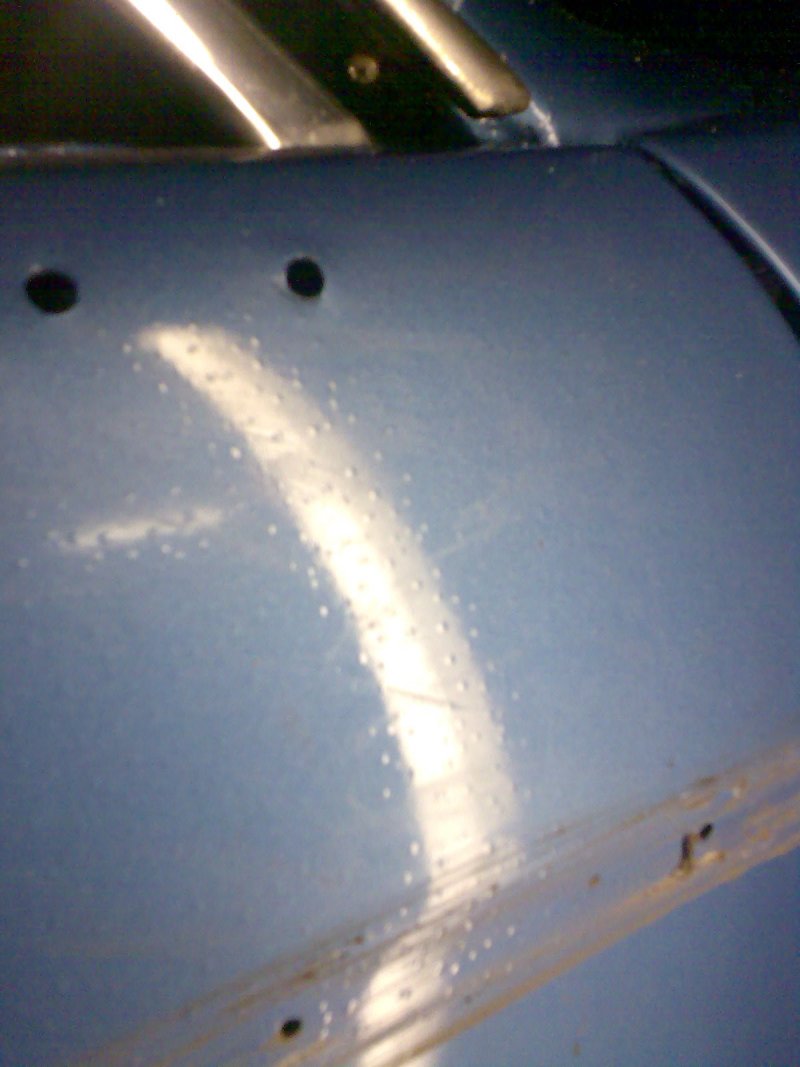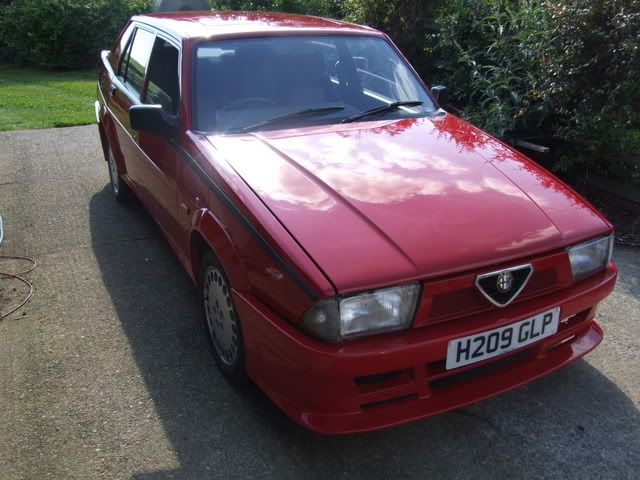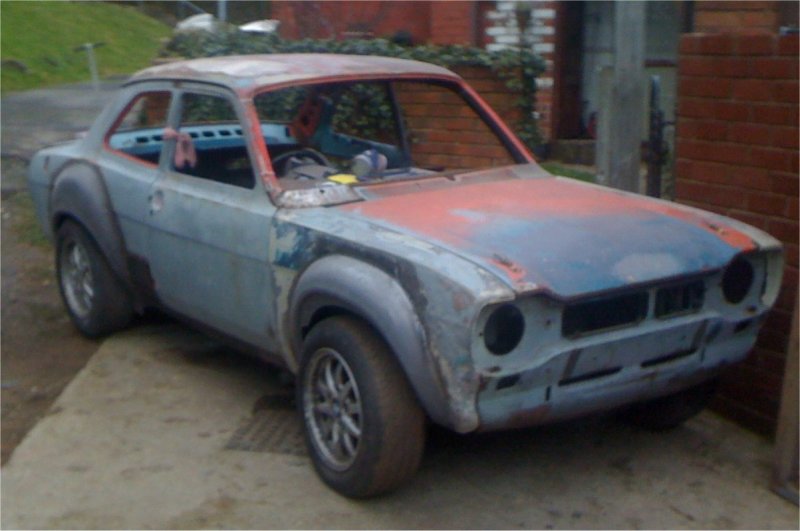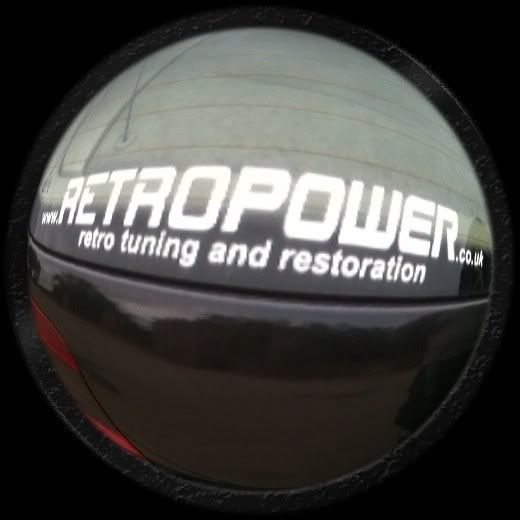75nut
Part of things
 
Posts: 512
|
|
Jun 15, 2012 15:36:53 GMT
|
|
Hi
Need to do a bit of rattle can spraying soon.
Now I always used to 600 grit wet sand primer before top coat, but I recently read the primer is porous and it could absorb the wet an allow it to contact bar metal below resulting in rusting a later date.
But dry sanding primer with 600 leads to clogging?
Advise please?
|
| |
90 Alfa 75 3.0 V6 Cloverleaf
79 MGB Roadster
88 Saab 900i Convertible
94 MK1 MX5 1.6
05 Volvo V70
|
|
|
|
|
|
|
Jun 15, 2012 15:47:43 GMT
|
its more a concern about trapped moisture damaging the paint on top than getting down to bare metal. This is one of those where you'll hear wildly conflicting opinions, and scare stories and all. I have wet sanded primer with no ill effects. Loads of other people have also. It is no longer considered good practice to wet sand primer due to risk of trapped moisture. If you want to dry sand primer you should use a sandpaper designed to be used dry only (not Wet&Dry which will clog quickly and risk scratching the primer). I use 3M Freecut paper for dry sanding. Its not the cheapest but its very good. Klingspor make good dry sanding paper too. |
| |
1941 Wolseley Not Rod - 1956 Humber Hawk - 1957 Daimler Conquest - 1966 Buick LeSabre - 1968 Plymouth Sport Fury - 1968 Ford Galaxie - 1969 Ford Country Squire - 1969 Mercury Marquis - 1970 Morris Minor - 1970 Buick Skylark - 1970 Ford Galaxie - 1971 Ford Galaxie - 1976 Continental Mark IV - 1976 Ford Capri - 1994 Ford Fiesta
|
|
|
|
|
Jun 15, 2012 15:50:02 GMT
|
Primer is pourus, as long as you let it harden properly and thoroughly dry it afterwards it should be fine, I always wet flat between stages when I'm using rattle cans. Btw I'd go with at least 800-1000 before top coat personally mate. That way you'll get a really smooth surface ready for basecoat. Then finish with 2-2.5k before laquer, and a nice fine cutting polish to finish and it should be like glass  |
| |
|
|
|
|
|
Jun 15, 2012 17:37:40 GMT
|
|
You can wet flat primer no problem. I'd go for 800,1000 to 1500 with a bucket of warm or tepid car wash. You basically want the primer to be "shiny"
|
| |
1993 Mercedes-Benz 190e LE in Azzuro Blue.
|
|
|
|
|
Jun 15, 2012 19:45:55 GMT
|
|
As professional paint sprayer I do not advocate using water to wet sand primer as you yourself have said Primer is Porus.What in effect means is that you will let the water through to the bare metal causing it to rust,another problem you can have in time is Micro bistering,this manifests itself as little bubles under the paint surface.
What you can use is as Alistairk has advocated 3m freecut paper or even Mirka Da discs.Yes I know others have said it works for them maybee it does time will tell.
If you have to rub primer down wet the only thing you can do is to use a hot air gun on it afterwards to dry hte moisture out of it.You will be amased how much will come out when you do.Yes of course I will use wet and dry to colour sand before buffing paint work to a high gloss shine but what you have to remeber is that the gloss seals the primer up and is impervious to water retention
Dave
|
| |
|
|
|
|
|
Jun 15, 2012 21:47:13 GMT
|
|
pretty much everyone has covered this! dry sand it mate, i went through stages of wet sanding and because i didnt let it dry(does take a while if you have not got proper facilities) it was pourous and then reacted with the top coat , since i have started to dry sand (use the proper paper!) i have had no problems at all.
|
| |
|
|
|
|
|
|
|
|
I really wouldn't go to 1000 grit before top coat. You start to risk paint adhesion problems doing that.
To ensure your paint sticks properly I'd stick with 600 or so for celly, 1K etc and 800 for 2K or polyester basecoat.
I don't get the idea of "shiny" primer - you are flatted back enough when all the gloss is *gone*. Thats why its called "flatting", because "flat" in this context means "matt". When all trace of shiny is gone you are keyed.
|
| |
1941 Wolseley Not Rod - 1956 Humber Hawk - 1957 Daimler Conquest - 1966 Buick LeSabre - 1968 Plymouth Sport Fury - 1968 Ford Galaxie - 1969 Ford Country Squire - 1969 Mercury Marquis - 1970 Morris Minor - 1970 Buick Skylark - 1970 Ford Galaxie - 1971 Ford Galaxie - 1976 Continental Mark IV - 1976 Ford Capri - 1994 Ford Fiesta
|
|
|
|
|
|
|
another problem you can have in time is Micro bistering,this manifests itself as little bubles under the paint surface. Dave yup moisture in the primer.....first frost we had, whole car looked like this  |
| |
"No............I think I'll stick with the Maxi"
Arther Daley
|
|
75nut
Part of things
 
Posts: 512
|
|
Jun 16, 2012 15:08:49 GMT
|
|
Cheers guys much appreciated! The info on specific sandpaper is good, I had never considered it and just bought any only stuff just concentrating on the grade.
I have seen that in paint on the last pic before, I wondered what it was down to.
I will be dry sanding from now on for sure I think.
|
| |
90 Alfa 75 3.0 V6 Cloverleaf
79 MGB Roadster
88 Saab 900i Convertible
94 MK1 MX5 1.6
05 Volvo V70
|
|
|
|
|
Jun 17, 2012 13:38:30 GMT
|
|
Fre-cut is ace. If you get a nylon brush, the size of a toothbrush (can find them in cheapo little packs of wire brushes etc), it'll take the clogged dust off the paper and it lasts longer. Or even just a toothbrush should do it.
I sand 1k a bit fine, like 800 or even 1000, cos it shows scratches in the next coat fairly easily. Being 50%-ish solvent, 1k colour onto prev 1k coats will bond, if it's wet enough (but not too heavy & wet else it'll pickle up).
|
| |
'66 Amazon <-> '94 LS400 <-> '86 Suzuki 1135 EFE
|
|
|
|
|
|
|
Jun 17, 2012 16:56:32 GMT
|
I don't get the idea of "shiny" primer I get what I mean ;D I spray a black guide coat on the primer, then I wet flat it with 800 to 1000 grit wet and dry. I've been doing it this way for yonks and I've never had any sort of paint reaction. Once it's panel wiped clean after flatting it has a sort of satin appearance, let the primer dry out, maybe apply some heat, then chuck on the paint. You could paint straight onto primer if you wanted, you flat the primer to get it smooth and flat for the paint. Everyone has different ways of doing things I suppose. There's no "wrong" way to do anything. Mirka foam backed DA discs are excellent for finishing paintwork off. Expensive though. |
| |
1993 Mercedes-Benz 190e LE in Azzuro Blue.
|
|
|
|
|
Jun 17, 2012 20:40:08 GMT
|
|
I'm just thinking that 1000 or 1500 grit is going to leave the primer too smooth for a rattle can paint to properly adhere too? 2K may be fine, but rattle can paint is purely mechanically attached to the primer so it needs some "texture" to stick to. I've never seen a manufacturer who recommended going into 4 figures for primer. But, if its working for you, fair enough, its very unusual practice though.
|
| |
1941 Wolseley Not Rod - 1956 Humber Hawk - 1957 Daimler Conquest - 1966 Buick LeSabre - 1968 Plymouth Sport Fury - 1968 Ford Galaxie - 1969 Ford Country Squire - 1969 Mercury Marquis - 1970 Morris Minor - 1970 Buick Skylark - 1970 Ford Galaxie - 1971 Ford Galaxie - 1976 Continental Mark IV - 1976 Ford Capri - 1994 Ford Fiesta
|
|
|
|
|
Jun 17, 2012 20:52:24 GMT
|
|
1000/1500 ect is fine,I tend to use that sort of grade for blending/blowing in colours,also I always wet sand primer I just think it gives a better finish myself,but I also let it dry either outside or in a warm workshop before paint
|
| |
Well you will mess with these cars....
Mk4 golf gttdi highline. Mk2 golf 1.8T
|
|
|
|
|
Jun 17, 2012 21:11:35 GMT
|
|
mmmmm, OK, tell you what, I have a silvery-blue job to do when I finally get my ass in gear on it, so I'll try going as fine as you guys are suggesting as I've never had a silver I was entirely happy with.
|
| |
1941 Wolseley Not Rod - 1956 Humber Hawk - 1957 Daimler Conquest - 1966 Buick LeSabre - 1968 Plymouth Sport Fury - 1968 Ford Galaxie - 1969 Ford Country Squire - 1969 Mercury Marquis - 1970 Morris Minor - 1970 Buick Skylark - 1970 Ford Galaxie - 1971 Ford Galaxie - 1976 Continental Mark IV - 1976 Ford Capri - 1994 Ford Fiesta
|
|
|
|
|
|
|
|
Even more so on silver,always found silver to show up imperfections easier than other colours
|
| |
Well you will mess with these cars....
Mk4 golf gttdi highline. Mk2 golf 1.8T
|
|
|
|
|
|
|
|
Don't wet flat primer?first I've heard of it.
We painted over 150 cars in my business and never once saw one with microblisters come back,I've still got 5 or so cars that we painted with none of the above problems.
In fact,I'd say your sacrificing the finish by not doing so.
All the cars mentioned above are kept outside in the rain,snow,sun etc and not pampered.
This is painting with 2k though,of course rattle cans could be different but the question asked then is,if your so keen on a good finish,why are you using rattle cans in the first place?
Granted the results can look OK but compared to a good gun job it's night and day.
|
| |
|
|
|
|
|
|
|
|
A guy I knew once painted a car in rattle cans, to prove you could do it and get as good a finish, the argument being that as long as you prep right and finish polish it right then if doesn't matter if you put the actual paint on with a garden hose or a bike pump.
I think it probably took a long long time and unless he had a special source for the paint cans it would have cost him enough to buy a compressor and all that stuff, but the finish was excellent.
Solid colour though. I suspect you'd have trouble getting the basecoat to lay out nice enough with rattle cans on a metallic. Although that said a mate did the front wings on an FE VX4/90 years ago with rattle cans and I'm sure that was metallic and it came out really nice. There were all kinds of "tricks" there though like they heated the cans first in the oven and applied the spray using a hairdryer... I don't recall it all but it was proper voodoo stuff.
|
| |
1941 Wolseley Not Rod - 1956 Humber Hawk - 1957 Daimler Conquest - 1966 Buick LeSabre - 1968 Plymouth Sport Fury - 1968 Ford Galaxie - 1969 Ford Country Squire - 1969 Mercury Marquis - 1970 Morris Minor - 1970 Buick Skylark - 1970 Ford Galaxie - 1971 Ford Galaxie - 1976 Continental Mark IV - 1976 Ford Capri - 1994 Ford Fiesta
|
|
|
|
|
|
|
I've always wet sanded primer, left it for a few days then top coated, never had a problem. On another note, i knew a guy whos grandparents painted a car using one of these:  With the right prep, a lot of pumping and a bit of flatting off it came out looking absolutely immaculate. I think its won a few awards over the years. As long as you get enough paint on and fairly uniform with it you would be surprised at what a good colour sanding can do. |
| |
1977 datsun 810 180b estate |
|
|
|
|
Jun 18, 2012 17:04:30 GMT
|
Honestly, you will get a better finish by flatting the primer with 1000, especially if you're spraying metallic. If it's too low grade, the meatalflakes will gather in the scratches. Oh, I use a Silverline HVLP spray station for my jobs  As for flatting and polishing, go for 1500 then onto 2000 wet and dry, then mop it off with water and G3. |
| |
1993 Mercedes-Benz 190e LE in Azzuro Blue.
|
|
|
|
|
Jun 18, 2012 17:15:37 GMT
|
|
Thats my whole point,
if your prep is good and you sand between each stage so each layer is smoother than a baboons bum then it doesnt matter how you applied the paint it just takes longer doing it by can and obviously you have to apply it differently. I mean if it wasnt for detailing look at the curse word finish most manufacturers get on their "factory" paint jobs.
I've done loads of work with rattle cans and you'd think it was done by an expensive gun.
Just make sure you use fine paper to ensure its smooth and that you don't leave scratches, do a good few coats of laquer and make sure you go over it with a mop and good polish to finish it like a mirror.
Going back onto wet flatting before primer, I've NEVER had micro blistering, infact to back up that its o.k to do it I stripped some alloys back to bare metal, etched then high build primered, wet flatted and left for over a year, no blistering, perfectly smooth and ready for top coat after a good clean.
|
| |
|
|
|
|















